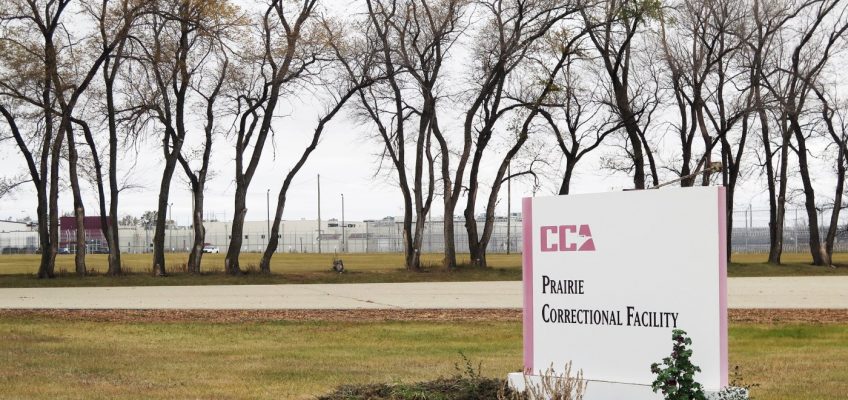APPLETON, Minn. — The Prairie Correctional Facility in western Minnesota could become a U.S. Immigration and Customs Enforcement detention center.
That’s according to new reporting from the Washington Post outlining the agency’s plans to double the number of people in detention.
The Trump administration is adding new detention facilities across the country to hold the growing number of immigrants it has arrested and accused of being in the country illegally. ICE centers were holding more than 56,000 immigrants in June, the most since 2019.
The Prairie Correctional Facility in Appleton has a capacity of 1,600 people, which would make it one of the nation’s largest immigration detention facilities.
Minnesota’s only private prison, it was shuttered in 2010 but has been a subject of debate for years. In 2023, the Minnesota House passed a bill that would ban private prisons in the state. That bill did not make it through the Senate.
More recently, two Republican legislators from western Minnesota have proposed using the Appleton prison to house inmates displaced from the planned closing of the Stillwater state penitentiary.
State leaders in May agreed to a phased closing of Stillwater, citing safety and costly maintenance concerns at the 1914 facility in Bayport. Plans call for the prison to be shuttered by July 2029.
However, the Minnesota Department of Corrections rejected the idea of using the Appleton prison, saying that the purchase and operation of the long-vacant facility “is not regarded as an effective or efficient use of state resources.”
Appleton and ICE planning
A Jan. 5, 2010, photo, shows the Prairie Correctional Facility in Appleton, Minn. Republicans pushed legislation though a committee on Tuesday, March 22, 2016, to re-open a privately run prison in western Minnesota despite repeated interruptions from protesters who briefly halted debate as they pushed lawmakers to instead consider ways to decrease the state’s prison population. GOP lawmakers have targeted the Prairie Correctional Facility in Appleton, as a way to ease Minnesota’s overcrowded prisons. (Mark Steil/Minnesota Public Radio via AP) MANDATORY CREDIT
ICE confirmed planning documents obtained by the newspaper were real, but said they were not final plans, said Washington Post reporter Douglas MacMillan.
Many local governments told the Post they did not have contracts with ICE — but that doesn’t mean new facilities couldn’t quickly develop.
“In some cases, it seems like this road map is aspirational,” MacMillan told MPR News. “What we have seen in the past six months is that this agency, under Trump, is willing to move into an area very quickly and try to fill it with migrants in a matter of weeks or months.”
Appleton City Administrator John Olinger told MPR News the city is not in communication with ICE and does not have a contract, but that Prairie Correctional owner CoreCivic is “aggressively pursuing” a contract with ICE.
In a statement, CoreCivic said of the Appleton facility, “We continue to explore opportunities with our government partners for which this site could be a viable solution.”
Elsewhere
Meanwhile, Nebraska announced plans Tuesday for an immigration detention center in the remote southwest corner of the state.
The facility will be dubbed the “Cornhusker Clink,” a play on Nebraska’s nickname of the Cornhusker State and an old slang term for jail. The alliterative name follows in the vein of the previously announced “Alligator Alcatraz” and “Deportation Depot” detention centers in Florida and the “Speedway Slammer” in Indiana.
Republican Gov. Jim Pillen said he and Department of Homeland Security Secretary Kristi Noem had agreed to use an existing minimum security prison work camp in McCook — a remote city of about 7,000 people in the middle of the wide-open prairies between Denver and Omaha — to house people awaiting deportation and being held for other immigration proceedings. It’s expected to be a Midwest hub for detainees from several states.
Opposition
The “Alligator Alcatraz” facility in Florida has also been the subject of legal challenges by attorneys who allege violations of due process there, including the rights of detainees to meet with their attorneys, limited access to immigration courts and poor living conditions. Critics have been trying to stop further construction and operations until it comes into compliance with federal environmental laws. It’s designed to hold up to 3,000 detainees in temporary tent structures.
Florida Gov. Ron DeSantis announced last week that his administration is preparing to open a second facility, dubbed “Deportation Depot,” at a state prison in north Florida. It’s expected to have 1,300 immigration beds, though that capacity could be expanded to 2,000, state officials said.
Related Articles
Appeals court allows Trump to end temporary protections for migrants from Central America and Nepal
As hurricane season collides with immigration agenda, fears increase for those without legal status
Immigrants seeking lawful work and citizenship are now subject to ‘anti-Americanism’ screening
Nebraska announces plan for immigration detention center dubbed the ‘Cornhusker Clink’
Julio César Chávez Jr. deported to Mexico for alleged cartel ties and drug trafficking
Also last week, officials in the rural Tennessee town of Mason voted to approve agreements to turn a former prison into an immigration detention facility operated by a private company, despite loud objections from residents and activists during a contentious public meeting.
And the Trump administration announced plans earlier this month for a 1,000-bed detention center in Indiana that would be dubbed “Speedway Slammer,” prompting a backlash in the Midwestern state that hosts the Indianapolis 500 auto race.
This report includes reporting from the Pioneer Press and the Associated Press.


Leave a Reply